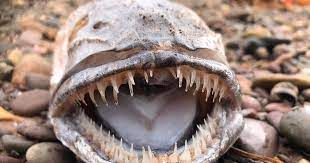Hidden beneath the ocean’s depths lies a creature that epitomizes stealth and danger: the Stonefish. These masters of disguise are as enigmatic as they are venomous. In this article, we’ll uncover 60 captivating facts about Stonefish, a true marvel of the deep.

1. Oceanic Ninjas: Stonefish are formidable predators lurking in the coral reefs and seabeds of the Indo-Pacific region.
2. The Camouflage Kings: Their name is derived from their uncanny resemblance to rocks and stones, making them virtually invisible to prey and predators alike.
3. Venomous Arsenal: Stonefish possess potent venom that can cause excruciating pain, paralysis, and, in extreme cases, death in humans.
4. Venomous Dorsal Spines: Their most lethal weapon is a row of sharp dorsal spines laden with venom glands.
5. Size Variability: Stonefish can range in size from just a few inches to over a foot long.
6. Patient Predators: They are ambush predators, often lying in wait for unsuspecting prey to swim by.
7. Slow-Moving Swimmers: Despite their agility, Stonefish are slow swimmers, relying on their camouflage to get close to prey.
8. Clever Mimicry: Some species have skin flaps that resemble algae, enhancing their camouflage.
9. Feeding Habits: Stonefish feast on smaller fish, shrimps, and crabs that venture too close.
10. Ancient Existence: They are among the oldest living species, with ancestors dating back millions of years.
11. Cryptic Coloration: Stonefish come in various colors, matching their surroundings perfectly.
12. Geographic Range: They are primarily found in the warm waters of the Indian and Pacific Oceans.
13. Not Just One Species: There are at least five recognized species of Stonefish.
14. Respiratory Adaptations: Stonefish have a unique ability to extract oxygen from water through their skin.
15. Reproductive Peculiarities: Stonefish have complex mating rituals, involving the release of sperm and eggs into the water.
16. Life Expectancy: In the wild, they can live up to 15 years, depending on species and environmental conditions.
17. Predators of Stonefish: Despite their venomous defense, they have some natural predators, including sea snakes and sharks.
18. Human Encounters: Accidental encounters with Stonefish can lead to severe injuries.
19. Native Remedies: Indigenous cultures have developed treatments for Stonefish stings, using heat to denature the venom.
20. Protected Species: In some regions, Stonefish are protected due to their vital role in the marine ecosystem.
21. Elusive Sightings: Given their camouflage and reclusive nature, sightings of Stonefish in the wild are rare.
22. Aquarium Attractions: Stonefish are sometimes kept in public aquariums, allowing people to observe them up close.
23. Aquatic Biotopes: They are essential components of coral reef ecosystems.
24. Unique Adaptations: Stonefish possess specialized adaptations that allow them to thrive in their challenging environments.
25. Cannibalistic Tendencies: In times of scarcity, Stonefish may resort to cannibalism.
26. Gradual Movement: Their slow, deliberate movements help them conserve energy while stalking prey.
27. Underwater Survivors: Stonefish can tolerate a wide range of water temperatures and salinity levels.
28. Hunting Techniques: They use a “sit and wait” strategy, staying perfectly still until prey comes close.
29. Territorial Creatures: Stonefish can be territorial, defending their chosen hunting grounds.
30. Lifelike Appearance: Stonefish have perfected the art of looking like an inanimate object.
31. Color Change: Some species can change their coloration to match different backgrounds.
32. Venomous Swallowing: Stonefish can inject venom into prey before swallowing it whole.
33. Sensory Adaptations: They have highly developed sensory organs to detect nearby movement.
34. Venomous Evolution: The potency of their venom has evolved to suit their hunting needs.
35. Ecological Significance: Stonefish play a crucial role in controlling the population of smaller reef-dwelling species.
36. Conservation Efforts: Increased awareness has led to efforts to protect and conserve Stonefish populations.
37. Lifelong Learners: Scientists are still unraveling the mysteries of Stonefish behavior and biology.
38. Prime Photography Subjects: Underwater photographers cherish spotting these elusive creatures.
39. Environmental Threats: Coral reef degradation threatens the habitats where Stonefish reside.
40. Divers’ Caution: Scuba divers are trained to recognize and avoid contact with Stonefish.
41. Medicinal Potential: Scientists are studying Stonefish venom for potential medical applications.
42. Unique Respiratory Structures: They have specialized gill chambers that aid in respiration.
43. Latitudinal Distribution: Their distribution can vary with changing water temperatures.
44. Feeding Territories: Stonefish often have well-defined territories for hunting.
45. Molt and Growth: They undergo molting as part of their growth process.
46. Breeding Seasons: Mating and reproduction are often synchronized with lunar cycles.
47. Aquatic Allies: Stonefish sometimes share their habitats with other reef creatures.
48. Parental Care: Some species exhibit parental care, guarding their eggs until hatching.
49. Altered Venom Composition: Different Stonefish species have varying venom compositions.
50. Evasive Maneuvers: Stonefish can make sudden bursts of speed when capturing prey.
51. Oceanic Predators: They are efficient hunters in the underwater food chain.
52. Biodiversity Hotspots: Coral reefs where Stonefish reside are biodiversity hotspots.
53. Fragile Ecosystems: Stonefish are indicators of the health of coral reef ecosystems.
54. Deep-Sea Adaptations: Some Stonefish species inhabit deeper waters.
55. Invasive Species Impact: Invasive species can disrupt Stonefish habitats.
56. Reef Restoration: Conservationists work to restore coral reefs, benefiting Stonefish populations.
57. The “World’s Most Venomous” Title: Stonefish are often touted as the world’s most venomous fish.
58. Warning Displays: They may display warning colors if threatened.
59. Adaptation to Change: Stonefish have adapted to various environmental shifts over millennia.
60. Awe-Inspiring Diversity: The diversity within the Stonefish genus continues to astonish scientists.



















Add Comment